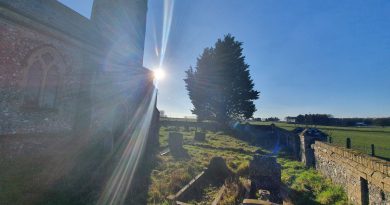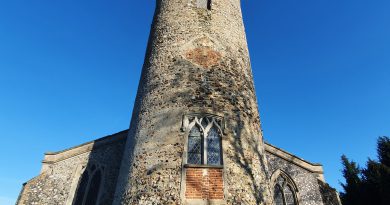Haveringland – St. Peter’s Church
Initially, not a lot made sense about this church as the road layout was illogical and the building was set back about 200 metres from the road. It’s not entirely normal for a church to be located at the end of a long concrete (or whatever it is) track and nor for there to be such a lack of road access.
This is though the answer, the airfield of RAF Swannington, which was in use between 1944 and 1947. There were plans to turn it into a larger airfield after this, but those plans didn’t come to fruition and the land was sold by the RAF in 1957 and the land returned to agriculture. The church is just visible on the above map (which is an Ordnance Survey map, just out of copyright) on the extreme right-hand side.
We pondered whether this was wide enough to be a runway, it didn’t feel quite right in terms of the size, but it was the map which confirmed that this was the perimeter of the airbase. Sections of the runways themselves are still visible on overhead maps, but not to the size that they once were.
Some of the memorials relating to the airbase.
Onto the church, I saw this and was a little disappointed as it’s just Victorian (not that everything Victorian is bad, but it does mean the medieval heritage of the building isn’t going to be there). With the exception of the tower, the church was demolished and rebuilt in 1858 by the owners of the nearby, and now demolished, Haveringland Hall. The listed building record notes that the thirteenth century font has been kept, but everything else is Victorian. The church was locked, but I’m not entirely sure that there was much to see inside.
Ignoring all the nearby concrete of the former airfield, it’s a remote and quite charming area.
A gateway that has long since fallen into disuse.
The porchway is Victorian, but that tower looks magnificent. It was noted in a newspaper article in the 1890s that the scale fern that was on the building had now been removed, a decision which was probably beneficial to the structure of the church. It’d have been a shame if that tower was covered in ivy, not just as it would be damaging to the stonework, but because it’d hide the beautiful round tower.
Some of the Victorian stonework on the side of the porch.
So, onto the round tower, which dates from the eleventh century. It’s one of the oldest surviving round towers in the country, although they faffed about with the top of it during the Victorian rebuild.
I think that’s Roman brick.
The window height has been changed on the tower and bricks placed under the new window, but it gives it all some character. Some of the tower has been rendered, likely in the 1850s, although some of that has since fallen away and not been replaced.
I’m not quite sure what all of these metal attachments are to the church tower. Perhaps they were used to stabilise the tower whilst they were demolishing the rest of the building in the Victorian period, or as some sort of support for plants. Although the bulk of the historic church has been lost, at least this tower remains, having spent centuries looking over agricultural workers and then for a few years there were military aircraft taking off in its shadow. The tower at least is perhaps an unlikely survivor, but at nearly 1,000 years old it’s not looking in bad condition.




















